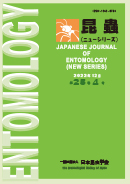Volume 25, Issue 4
Displaying 1-28 of 28 articles from this issue
- |<
- <
- 1
- >
- >|
-
2022 Volume 25 Issue 4 Pages 153-164
Published: December 25, 2022
Released on J-STAGE: December 25, 2022
Download PDF (8294K)
-
2022 Volume 25 Issue 4 Pages 165-170
Published: December 25, 2022
Released on J-STAGE: December 25, 2022
Download PDF (12268K) -
2022 Volume 25 Issue 4 Pages 171-173
Published: December 25, 2022
Released on J-STAGE: December 25, 2022
Download PDF (11333K)
-
2022 Volume 25 Issue 4 Pages 174-176
Published: December 25, 2022
Released on J-STAGE: December 25, 2022
Download PDF (8870K) -
2022 Volume 25 Issue 4 Pages 177-180
Published: December 25, 2022
Released on J-STAGE: December 25, 2022
Download PDF (6068K) -
2022 Volume 25 Issue 4 Pages 181-182
Published: December 25, 2022
Released on J-STAGE: December 25, 2022
Download PDF (2613K)
-
2022 Volume 25 Issue 4 Pages 183-186
Published: December 25, 2022
Released on J-STAGE: December 25, 2022
Download PDF (1484K) -
2022 Volume 25 Issue 4 Pages 187-188
Published: December 25, 2022
Released on J-STAGE: December 25, 2022
Download PDF (5055K) -
2022 Volume 25 Issue 4 Pages 189-190
Published: December 25, 2022
Released on J-STAGE: December 25, 2022
Download PDF (1539K) -
2022 Volume 25 Issue 4 Pages 191-192
Published: December 25, 2022
Released on J-STAGE: December 25, 2022
Download PDF (2484K) -
2022 Volume 25 Issue 4 Pages 193-194
Published: December 25, 2022
Released on J-STAGE: December 25, 2022
Download PDF (2593K) -
2022 Volume 25 Issue 4 Pages 195-196
Published: December 25, 2022
Released on J-STAGE: December 25, 2022
Download PDF (2120K)
-
2022 Volume 25 Issue 4 Pages 197
Published: December 25, 2022
Released on J-STAGE: December 25, 2022
Download PDF (215K) -
2022 Volume 25 Issue 4 Pages 197-198
Published: December 25, 2022
Released on J-STAGE: December 25, 2022
Download PDF (219K) -
2022 Volume 25 Issue 4 Pages 198
Published: December 25, 2022
Released on J-STAGE: December 25, 2022
Download PDF (188K) -
2022 Volume 25 Issue 4 Pages 199
Published: December 25, 2022
Released on J-STAGE: December 25, 2022
Download PDF (193K) -
2022 Volume 25 Issue 4 Pages 199
Published: December 25, 2022
Released on J-STAGE: December 25, 2022
Download PDF (193K) -
2022 Volume 25 Issue 4 Pages 200
Published: December 25, 2022
Released on J-STAGE: December 25, 2022
Download PDF (193K) -
2022 Volume 25 Issue 4 Pages 200
Published: December 25, 2022
Released on J-STAGE: December 25, 2022
Download PDF (193K) -
2022 Volume 25 Issue 4 Pages 200
Published: December 25, 2022
Released on J-STAGE: December 25, 2022
Download PDF (193K) -
2022 Volume 25 Issue 4 Pages 201
Published: December 25, 2022
Released on J-STAGE: December 25, 2022
Download PDF (208K) -
2022 Volume 25 Issue 4 Pages 201
Published: December 25, 2022
Released on J-STAGE: December 25, 2022
Download PDF (208K) -
2022 Volume 25 Issue 4 Pages 202
Published: December 25, 2022
Released on J-STAGE: December 25, 2022
Download PDF (138K) -
2022 Volume 25 Issue 4 Pages 203-205
Published: December 25, 2022
Released on J-STAGE: December 25, 2022
Download PDF (191K)
-
2022 Volume 25 Issue 4 Pages cover1-
Published: December 25, 2022
Released on J-STAGE: December 25, 2022
Download PDF (127K) -
2022 Volume 25 Issue 4 Pages cover2-
Published: December 25, 2022
Released on J-STAGE: December 25, 2022
Download PDF (476K) -
2022 Volume 25 Issue 4 Pages cover3-
Published: December 25, 2022
Released on J-STAGE: December 25, 2022
Download PDF (150K) -
2022 Volume 25 Issue 4 Pages cover4-
Published: December 25, 2022
Released on J-STAGE: December 25, 2022
Download PDF (143K)
- |<
- <
- 1
- >
- >|
